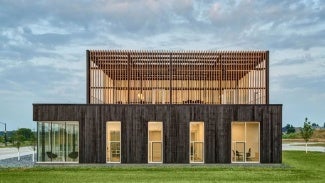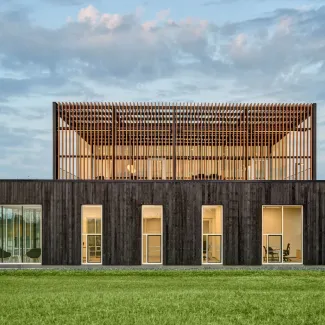Justice Facilities Review Award
Recognizes best practices in planning & design for buildings that directly support the justice system.

For more information on opening and deadline dates, please see the AIA Awards FAQ.
Recognizing the best in justice architecture design
The Justice Facilities Review (JFR) is published yearly and documents best practices in planning and design for justice architecture. The JFR offers examples of a broad range of design strategies and depicts the latest trends in the design and construction of buildings that directly support the justice system. These projects demonstrate the quality of form, functionality, and current architectural responses to complex justice design issues. The JFR program is sponsored by the Academy of Architecture for Justice, an AIA Knowledge Community. Share your exceptional work with your peers today.
Examples of building types that support the justice system include:
- courthouses
- corrections/detention
- law enforcement
- land ports of entry
- public safety buildings
- border patrol stations
- substance abuse treatment facilities
- transition / step down housing
- forensic laboratories
- forensic behavioral health facilities
- medical examiner facilities
- emergency operations
Essential elements for identifying the success of these projects are:
- functionality
- security and safety
- technology and accessibility
- community impact
- sustainability and economic feasibility (first cost and long-term cost of ownership)
- aesthetic achievements
If you have a unique project that you think meets the requirements and spirit, please submit using the link below.
The Justice Facilities Review awards program is administered by the Academy of Architecture for Justice, an AIA Knowledge Community.
Questions? Email AIA Awards
Eligibility & Judging Criteria
The jury evaluates entries based on how successfully projects have met their individual requirements. Entries are judged individually—not in competition with each other.
Entrants
- This award is open to AIA members and non-members based in the U.S. or internationally
- Projects submitted by jury members or by the organizations they represent, and projects that included jury members on their team, will be disqualified.
- All entries must receive permissions from owners and other team members and acknowledge that permission as part of the submission.
- Communication with jurors by the entrants is inappropriate and cause for disqualification. All architects of selected projects must verify that neither they nor persons acting on their behalf, had any written or other communication with any juror regarding any submitted project from the time of submittal to completion of the jury process.
Projects
· Projects can be either Completed (Construction completed after 1/1/2019) or Unbuilt (100% DD completed after 1/1/2019).
· Unbuilt projects can be submitted with presentation graphics, models and renderings in lieu of photographs. Unbuilt projects must be completed through 100% Design Development.
· Unbuilt project award recipients may re-submit the project once it is constructed.
· Any project that credits a jury member or firm as lead architect is ineligible and will be disqualified if submitted.
Awards criteria
Citations will be given to projects that demonstrate excellence in all six (6) essential elements of justice facility design outlined above. In addition to the citations, a number of additional projects will be selected by the jury for publication in the Justice Facilities Review.
The jury has the discretion to waive the citation award requirement to excel in all six (6) essential elements if they deem the project is exceptional in meeting the needs of all users or provides an exemplary solution to an atypical design challenge. The number of citations and published projects will be at the sole discretion of the jury.
National recognition and publication
This program offers AIA members, architects, designers, justice planners, and community organizers an opportunity to be nationally recognized. Recipient projects reach an audience of elected and other public officials, community groups, court managers, law enforcement officials, facilities managers, and other client groups through online and in-person programs. The recipients will be announced to the members of the Academy of Architecture for Justice and selected projects will be showcased with imagery and narratives on AIA.org and featured in the AAJ design awards publication. Clients and architects typically accept their award certificate on stage at the Justice Facilities Review (JFR) award celebration at the AAJ fall conference. Selected projects may also be featured in a number of publications, presentations, and conferences, or included in other AAJ-sponsored media presentations. Likewise, recipients may be invited to present their work at AAJ and partner conferences.
Descriptive metrics and supporting documentation are required for the submission. Successful submissions highlight the unique aspects of the project as well as the roles the architect and the team played in the development of the solution.
The supporting documentation should tell a compelling story of your project through images and narrative text. It must be uploaded as a single PDF file—max 20 MB, 15 pages—and include color photographs, renderings, drawings, and diagrams of the final design that clearly show the design solution.
Include:
- Appropriate imagery to support your story and to communicate effectively to the jury (interior and exterior images).
- Narrative text describing the project goals, program elements, notable features, opportunities and challenges, stakeholder engagement, innovative technologies, and/or security features relevant to the project.
- Floor plans, elevations, and sections, labeled and legible as full-page print graphic.
- Site plan(s) including surrounding context, north arrow and identification of project location.
- Imagery and plans can be combined where appropriate. Show all scales graphically.
Note:
- It is the responsibility of the submitter to check that the files uploaded open and can be viewed as intended. Entrants may log in and out of the submission site until the deadline.
- Upon the jury's final selection, you may be contacted to provide additional high-resolution images.
- Winning submissions become the property of the AIA Library and Archives.
Submission process:
The deadline for submission completion is strictly observed. Payment is collected after the application has been completed and submitted. Firms considering submission may login and start a submission to review the application form without incurring the fee.
A sample application can be viewed here: 2023 Justice Facilities Review Sample Application
Please note: Some components of the sample application are subject to change from the final version and are merely here to allow a submitter to view the major criteria prior to logging on to the awards platform. Please rely on the online awards platform for the final criteria.
Fees:
Single project submissions are $450 each. Submitting the same project to additional award categories costs an extra $100 per category.
2023
Silvia Cheng, AIA, Chair, STV Group, Inc., New York
Hon. Judge Rachel Bell, Metropolitan Nashville & Davidson County, Nashville, Tenn.
Derwin Broughton, AIA, KAI, Dallas
Shirley Moore Smeal, Moore Smeal & Associates, Mechanicsburg, Pa.
Erin Persky, Assoc. AIA, Erin Persky & Associates, San Diego
2023 winners
Lowell Justice Center, Finegold Alexander Architects, Lowell, Mass.
Marion Fire Station No. 1, OPN Architects, Marion, Iowa
Ontario Court of Justice Toronto, NORR Architects & Engineers Limited, Renzo Piano Building Workshop, Toronto
Polk County Historic Courthouse, OPN Architects, Des Moines, Iowa
Past winners
Contact us for information on prior years' winners.



